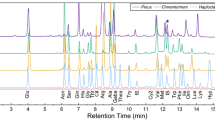Abstract
The Lizada and Yang method, commonly used for analyzing 1-aminocyclopropane-1-carboxylic acid (ACC), the immediate precursor of the plant hormone ethylene, is subject to interference and lacks internal standards. The use of combined gas chromatography-mass spectrometry (GC-MS) overcomes these shortcomings but the method is expensive and unavailable to many laboratories. We describe an alternative physico-chemical method using a capillary column gas chromatograph fitted with a standard nitrogen/phosphorus detector. After forming the N-benzoyl n-propyl derivative, measurements of ACC concentrations in extracts of leaves and in xylem sap of tomato plants using the nitrogen/phosphorus detector were within 10% of those obtained by GC-MS. Concentrations in plants grown in well-drained soil were approximately 0.16 nmol g−1 fresh weight (leaves) and 0.04–0.01 mmol m−3 (sap). Flooding the soil for 48–72 h increased these values approximately 9-fold.
Similar content being viewed by others
References
Osborne DJ (1989) The control role of ethylene in plant growth and development. In: HClijsters, MDeProft, RMarcelle and MVanPoucke, eds. Biochemical and physical aspects of ethylene production and action in lower and higher plants. pp 1–11. Dordrecht: Kluwer Academic Publishers
Yang SF, Adams DO, Lizada C, Bradford KJ, Cameron AC and Hoffmann NE (1979) Mechanism and regulation of ethylene biosynthesis. In: F.Skoog, ed. Plant Growth Substances 1979, pp 219–229. Berlin: Springer-Verlag
Yoshii H and Imaseki H (1982) Regulation of auxin-induced ethylene biosynthesis. Repression of inductive formation of 1-aminocyclopropane-1-carboxylate synthase by ethylene. Plant Cell Physiol 23: 639–649
Hamilton AJ, Lycett GW and Grierson D (1990) Antisense gene that inhibits synthesis of the hormone ethylene in transgenic plants. Nature 346: 284–287
Ververidis P and John P (1991) Complete recovery in vitro of ethylene-forming enzyme activity. Phytochem 30: 725–727
Lizada CC and Yang SF (1979) A simple and sensitive assay for 1-aminocyclopropane-1-carboxylic acid. Anal Biochem 100: 140–145
Boller T, Herner RC and Kende H (1979) Assay for and enzymatic formation of an ethylene precursor, 1-aminocyclopropane-1-carboxylic acid. Planta 145: 293–303
McGraw BA, Horgan R and Heald JK (1985) Selected ion monitoring/isotope dilution mass spectrometric determination of 1-aminocyclopropane-1-carboxylic acid levels in ripening tomato fruit. Anal Biochem 149: 130–135
Hall KC, Pearce DME and Jackson MB (1989) A simplified method for determining 1-aminocyclopropane-1-carboxylic acid (ACC) in plant tissues using a mass selective detector. Plant Growth Regul 8: 297–307
Wang TW and Arteca RN (1992) Effects of low O2 root stress on ethylene biosynthesis in tomato plants (Lycopersicon esculentum Mill. cv Heinz 1350). Plant Physiol 98: 97–107
Jackson MB, Gales K and Campbell DJ (1978) Effect of waterlogged soil conditions on the production of ethylene and on water relationships in tomato plants. J Exp Bot 29: 183–193
Finlayson SA, Foster KR and Reid DM (1991) Transport and metabolism of 1-aminocyclopropane-1-carboxylic acid in sunflower (Helianthus annuus L.) seedlings. Plant Physiol 96: 1360–1367
Bradford KJ and Yang SF (1980) Xylem transport of 1-aminocyclopropane-1-carboxylic acid, an ethylene precursor in waterlogged plants. Plant Physiol 65: 322–326
Jackson MB (1993) Are plant hormones involved in root to shoot communication? Advances in Botanical Research 19: 103–187
Else MA, Davies WJ and Jackson MB (1992) Knowledge of xylem sap flow rate is a pre-requisite for accurate estimates of hormone transport from roots to shoots. J Exp Bot 43: 69 abstract P.11.17
Author information
Authors and Affiliations
Rights and permissions
About this article
Cite this article
Hall, K.C., Else, M.A. & Jackson, M.B. Determination of 1-aminocyclopropane-1-carboxylic acid (ACC) in leaf tissue and xylem sap using capillary column gas chromatography and a nitrogen/phosphorus detector. Plant Growth Regul 13, 225–230 (1993). https://doi.org/10.1007/BF00024842
Received:
Accepted:
Issue Date:
DOI: https://doi.org/10.1007/BF00024842




